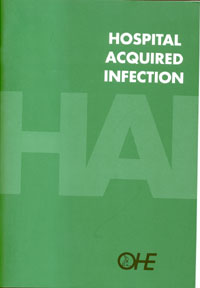‘About one in ten patients in acute hospitals at any one time has an infection acquired after admission to hospitals’ (DH/PHLS, 1995, pi). This quotation, introducing…
‘About one in ten patients in acute hospitals at any one time has an infection acquired after admission to hospitals’ (DH/PHLS, 1995, pi). This quotation, introducing recent guidance on the control of infection in hospitals, gives us some indication of the size of…
‘About one in ten patients in acute hospitals at any one time has an infection acquired after admission to hospitals’ (DH/PHLS, 1995, pi). This quotation, introducing recent guidance on the control of infection in hospitals, gives us some indication of the size of the problem and the reasons for concern about the risks to health and the demands on scarce resources engendered by potentially reducible hospital acquired infection (HAI). HAI or nosocomial infection has been described as an infection, not present on admission, but acquired during a stay in hospital, that manifests itself either during the stay in hospital or in the period following a hospital stay (Haley, 1986). The main types are urinary tract infections (UTI), surgical wound infections (SWI) and respiratory tract infections (RTI). Estimations of the costs of HAI to the health sector vary depending on the type of infection, age of the patient and the type of costs included in the study (DH/PHLS, 1995). Coello et al. (1993) estimated the mean extra cost of treating a patient with a UTI to be £467 and the extra cost associated with treating a patient who acquired a SWI or more than one infection to be £1,454 and £3,362 respectively. Pittet et al. (1994) estimated the cost per case of septicaemia to be £25,753. The national burden of HAIs occurring in surgical patients was estimated to be over £170m to the hospital sector in England (Coello et al, 1993). Costs that fall outside the hospital sector and impose burdens on community services, patients and their families have not been included. It has been estimated that approximately 30 per cent of HAIs can be prevented (Haley et al, 1985b).
Infections acquired in hospitals are likely to complicate illness, cause discomfort and anxiety and can lead to death. Resources are required to implement infection control programmes and to diagnose and treat patients. The former include the costs of specialist doctors, nurses and microbiologists employed to prevent and control infection and undertake surveillance, and the costs associated with diagnostic tests and prophylactic interventions that are undertaken whether an infection occurs or not. The hospital infection control team is used to identify certain infections, prevent secondary cases occurring and control outbreaks. Additional help may be needed from specialists in infectious disease control in the community and sometimes from experts in national centres of disease control. Health sector resources are used to diagnose and treat patients who acquire an infection during their hospital stay. Patients, families and industry may also experience additional costs resulting from the impact of infection. The costs of infection are thus distributed amongst hospitals, community services, patients, their families and industry. The distribution of these costs will depend to some extent upon the organisation of the health care system, admission and discharge policies and the interface between primary and secondary care. Given that many health care systems are changing, that lengths of stay are shrinking and that financial accountability is both more transparent and more stringent, it is not surprising that the financial implications of HAI are of particular contemporary interest.
Economic evaluation has a role to play in the policy for and management of HAI. It can help to determine the cost-effectiveness of alternative regimes for controlling and managing infections within hospitals, and the cost-effectiveness of particular types of interventions to prevent infection occurring or limit its spread. However, economic evaluations in the area of HAI are fraught with problems related to case definition, detection and the attribution of the costs to the infection. These issues will be reviewed below.
The next section of this report sets the historical context for discussion of HAI, which has been recognised for centuries. This is followed by a description of the aetiology, prevalence and incidence of HAI and its impact on mortality. The strategies that might be employed to prevent infections are briefly discussed; and an outline is given of the organisational arrangements to control infection in hospitals and the costs likely to be associated with such arrangements. Economic evaluative studies are then reviewed in the light of the methodological issues that are encountered by analysts undertaking work in this area. Gaps in our knowledge are indicated and policy implications are considered.
